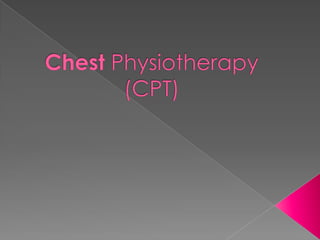
CPT Techniques and Benefits for Lung Health
- 2. Objectives
- 3. Definition Chest physical therapy is the term for a group of treatments designed to improve respiratory efficiency, promote expansion of the lungs, strengthen respiratory muscles, and eliminate secretions from the respiratory system
- 4. Definition Chest Physiotherapy is the removal of excess secretions (also called mucus, phlegm, sputum) from inside the lungs, by physical means. It is used to assist a cough, re-educate breathing muscles and to try to improve ventilation of the lungs.
- 5. the excess secretions The lungs are kept moist with a thin film of fluid to stop them drying out. When there is a chest infection or occasionally in other situations, this fluid increases and becomes thick . In the normal situation, these secretions are removed by coughing
- 6. the excess secretions but this is not always possible in the presence of weakness, or in chronic lung disease. Although antibiotics can control the infection, they do not remove the secretions that occur. Some will be reabsorbed into the body but very thick ones will remain.
- 7. Why is it important to remove the secretions?
- 8. It is important to remove the secretions to allow more effective breathing and increase the amount of oxygen getting into the body. to help patients breathe more freely and to get more oxygen into the body
- 9. It is usually done in conjunction with other treatments to rid the airways of secretions. These other treatments include suctioning, nebulizer treatments, the administration of expectorant drugs.
- 10. Chest physiotherapy Chest physiotherapy includes :- postural drainage chest percussion chest vibration turning deep breathing exercises coughing positive expiratory pressure (PEP) valve
- 11. Postural Drainage It removes mucus from certain parts of the lungs by using gravity and properpositioning to bring the secretions into the throat where it is easier to remove them. The lungs are divided into segments called lobes, the right lung is divided intothree lobes(right upper lobe, right middle lobe and right lower lobe) while the left lung has only twolobes (left upper lobe and lower lobe
- 12. Postural drainage Postural drainage uses the force of gravity to assist in effectively draining secretions from the lungs and into the central airway where they can either be coughed up or suctioned out. The patient is placed in a head or chest down position and is kept in this position for up to 15 minutes. Critical care patients and those depending on mechanical ventilation receive postural drainage therapy four to six times daily. Percussion and vibration may be performed in conjunction with postural drainage.
- 13. Percussion Percussion is rhythmically striking the chest wall with cupped hands. It is also called cupping, clapping. The purpose of percussion is to break up thick secretions in the lungs so that they can be more easily removed. Percussion is performed on each lung segment for one to two minutes at a time.
- 15. Vibration is the placement of hands along the ribs in the direction of expiratory movement of the chest. A small rapid vibration (tremor) and slight pressure is applied during exhalation to accentuate this phase of the respiratory cycle. The maneuver mimics the forced exhalation of a cough. Mechanical devices used to perform vibration differ from the manual method in that the mechanical device is continuously applied during both inspiration and exhalation
- 16. Turning Turning from side to side permits lung expansion. Patients may turn themselves or be turned by a caregiver. The head of the bed is also elevated to promote drainage if the patient can tolerate this position. Critically ill patients and those dependent on mechanical respiration are turned once every one to two hours around the clock. Coughing Coughing helps break up secretions in the lungs so that the mucus can be suctioned out Patients sit upright and inhale deeply through the nose. They then exhale in short puffs or coughs. Coughing is repeated several times a day. Deep breathing Deep breathing helps expand the lungs and forces better distribution of the air into all sections of the lung. The patient either sits in a chair or sits upright in bed and inhales, pushing the abdomen out to force maximum amounts of air into the lung. The abdomen is then contracted, and the patient exhales. Deep breathing exercises are done several times each day for short periods.
- 17. Indications 1) Excessive sputum production 2) Reduced effectiveness of cough 3) History of success in treating a pulmonary problem with CPT 4) Adventitious breath sounds suggestive of secretions in the airways which persist after coughing 5) Change in vital signs 6) Abnormal chest radiograph suggesting atelectasis, mucus plugging. 7) Significant deterioration in the indices of gas exchange from baseline status
- 18. ASSESSMENT OF NEED: Sputum retention not responsive to spontaneous or directed coughing History of pulmonary problems treated successfully with postural drainage therapy Decreased breath sounds or adventitious sounds suggesting secretions in the airway Change in vital signs-increase in breathing frequency, tachycardia Abnormal chest radiograph consistent with atelectasis, mucus plugging, or infiltrates Deterioration in arterial blood gas values or oxygen saturation
- 19. ASSESSMENT OF OUTCOME: Change in sputum production. Change in breath sounds. Patient subjective response to therapy. Change in vital signs. Change in chest radiograph. Change in arterial blood gas values or oxygen saturation.
- 20. Adverse Reactions and Interventions 1) Hypoxemia. 2) Increases in Intracranial Pressure. 3) Acute hypotension during therapy. 4) Pulmonary Hemorrhage. 5) Pain or Injury to Muscles, Ribs or Spine.
- 21. Monitor the following throughout the therapy session. the patient's reaction to the therapy including subjective responses to pain discomfort and dyspnea heart rate and rhythm respiratory rate and pattern including work of breathing cough and sputum production including color, quantity, consistency, and odor breath sounds oxygen saturation by pulse oximeter blood pressure
- 22. http://www.answers.com/topic/chest-physical-therapy http://www.livingwithcerebralpalsy.com/chest-therapy.php http://www.jtsma.org.uk/in013.html http://www.jazannurses.com/vb/nurses10033.html http://www.merckmanuals.com/home/sec04/ch040/ch040h.html
